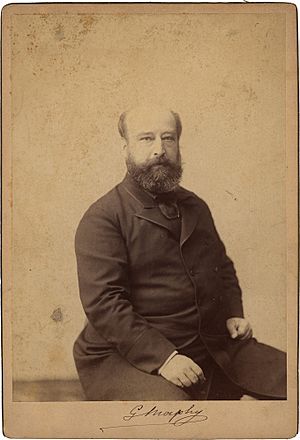Guillermo Morphy facts for kids
Quick facts for kids
Guillermo Morphy
Count
|
|
|---|---|
 |
|
| Born |
Guillermo Morphy y Ferríz de Guzmán
February 29, 1836 Madrid, Spain
|
| Died | August 28, 1899 (aged 63) |
| Other names | Conde Morphy or Count Morphy |
| Alma mater | Royal Academy of Fine Arts of San Fernando |
| Occupation | Spanish aristocrat, music critic, musicologist, historian, educator, composer and politician |
Guillermo Morphy y Ferríz de Guzmán (born February 29, 1836 – died August 28, 1899) was a Spanish nobleman, also known as Count Morphy. He was a very talented person who worked as a music critic, a music expert, a historian, a teacher, a composer, and even a politician.
Count Morphy became a personal secretary to King Alfonso XII of Spain in 1875. He was highly respected in Madrid's art world during the late 1800s. He was also a good friend to famous musicians like Isaac Albéniz. He even helped Albéniz get a special scholarship to study music in Brussels. Count Morphy also directed the Royal Concert Society at the Teatro Real in Madrid until 1891.
Life and Work
Guillermo Morphy was born in Madrid, Spain. His family had Irish roots. As a child, he traveled a lot through countries like France, Italy, and Germany. These travels helped him get a great education and made him love art and books. He lived in Germany for two years when he was young.
In 1858, he took over his father's law business. Later, in 1863, he took music classes from a famous composer named François-Joseph Fétis in Brussels. When he returned to Spain, he started working at the Royal Palace of Madrid. He became a gentleman for Prince Alfonso, who would later become King Alfonso XII. He held this job until 1868, when Queen Isabel II was removed from power.
Return to Spain and Royal Service
After leaving Spain, Morphy moved to France to study music even more. During a war, he traveled to Vienna to be with Prince Alfonso. While there, he wrote an opera called Lizzie and other music pieces.
When the King returned to power in Spain, Morphy came back with him. On January 18, 1875, the King made him his personal secretary. Then, on May 3, 1882, the King gave him the special title of Count Morphy. He wrote several studies and translated a book about the famous composer Beethoven. In 1892, he joined the Royal Academy of Fine Arts of San Fernando. He also led the Royal Concert Society at the Teatro Real in Madrid until 1891.
Helping Musicians and Arts
Count Morphy was a friend and helper to many important musicians of his time. These included Tomás Bretón, Pablo Casals, and Isaac Albéniz. He was especially close to Albéniz and believed strongly in his talent. Morphy helped Albéniz get a scholarship to study at the Royal Conservatory of Brussels. He also helped another musician, Enrique Fernández Arbós, study with a famous violinist named Henri Vieuxtemps. Albéniz even dedicated his music piece Sevilla to Count Morphy's wife.
In 1883, Count Morphy and other musicians started a group in Madrid. They wanted to improve Spanish art. They created the Philharmonic Institute to offer music training that was as good as other schools in Europe. This new school helped make singing better in Spain. It also helped Spanish opera become more popular.
From 1886 to 1895, Count Morphy was the president of the Fine Arts section of a society called the Ateneo. He gave talks and shared his ideas about art and music. He wanted to bring Spanish art up to date and make it more national. He also invited famous international artists and young Spanish artists to the Ateneo. This helped people learn more about European culture. During this time, the Ateneo became very lively with new vocal, instrumental, and chamber music. They also played new works by Spanish and European composers.
See also
 In Spanish: Guillermo Morphy para niños
In Spanish: Guillermo Morphy para niños

